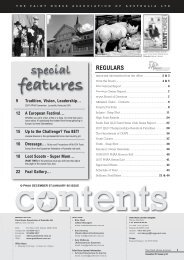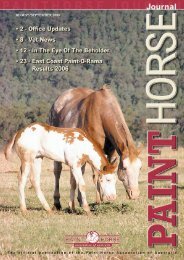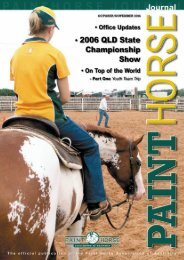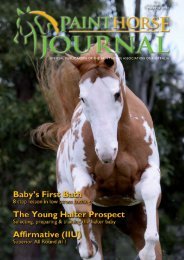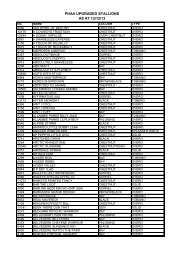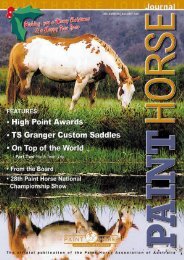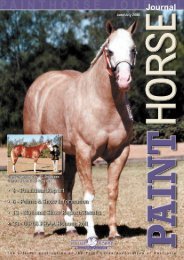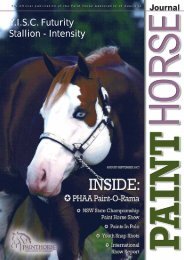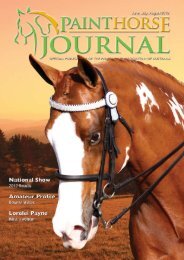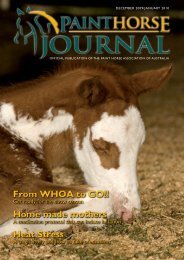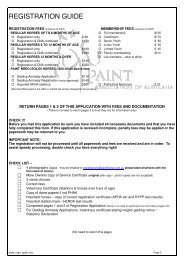PH - Paint Horse Association of Australia
PH - Paint Horse Association of Australia
PH - Paint Horse Association of Australia
Create successful ePaper yourself
Turn your PDF publications into a flip-book with our unique Google optimized e-Paper software.
Continued from page 17<br />
GREY GENES:<br />
Because the grey gene is dominant, it is relatively easy to get a grey<br />
horse. While the study <strong>of</strong> genes is by no means complete, we do know<br />
that genes occur in pairs, with each parent giving one <strong>of</strong> the pair to its<br />
<strong>of</strong>fspring. We can designate the gene for grey as “G” and the gene for<br />
nongrey as “g” to indicate that gray will dominate over non-grey. In<br />
other words, if a horse receives a “G” from one parent and a “g” from<br />
the other, it will grey because the “G” is dominant and the “g” is<br />
recessive. When a horse receives both a dominant and recessive gene,<br />
it is heterozygous for the trait it has one <strong>of</strong> each. If the horse receives<br />
two dominant genes (greying would be indicated by “GG”), then it is<br />
homozygous dominant, whereas if it receives two recessive genes<br />
(“gg”), then it is homozygous recessive.<br />
18<br />
Name: Melanie Hogan<br />
Lives: Thirlmere, Sydney, NSW<br />
• HOW LONG YOU’VE BEEN INVOLVED IN PAINTS.<br />
Seven years.<br />
• WHAT HAS YOUR CAREER IN PAINTS INCLUDED.<br />
I’ve had a few good ones and a few not so good ones but my<br />
main horse in the past was Artic Norma Jean.<br />
• YOUR CURRENT HORSE.<br />
Hillybilly Express AKA Kenny.<br />
• BEST SPECIAL MOMENT WITH YOUR PAINT.<br />
Travelling to South <strong>Australia</strong> for their State Titles in 2006, we<br />
met great people and enjoyed a well run fun packed show so<br />
much so we are planning to do it again this year.<br />
• WHAT DO YOU DO WITH YOUR PAINT.<br />
We mainly show at Western shows but have been known to<br />
show up at hack show every now and then. We trail ride<br />
regularly which is what helps kept both horse and rider sane.<br />
• WHAT IS YOUR MAIN GOAL WITH YOUR CURRENT HORSE.<br />
To keep enjoying showing and trail riding.<br />
• WHAT DO YOU LOVE ABOUT PAINTS AS A BREED.<br />
I like loud horses that stand out in a crowd and I find the<br />
<strong>Paint</strong> people are good to show with.<br />
• WHAT ARE YOUR TRAINING SECRETS.<br />
I love going to clinics and watching training videos and I think<br />
its important to keep an open mind about my opinions as you<br />
can be surprised by what you learn <strong>of</strong>f different people.<br />
• FAVOURITE EVENT AND WHY.<br />
Hunt Seat Equitation - I enjoy pattern work.<br />
• WHAT EVENT ARE YOU LOOKING FORWARD TO THIS.<br />
All <strong>of</strong> them as I’m in show mode.<br />
The <strong>Paint</strong> <strong>Horse</strong> Journal<br />
February - March 2007<br />
If a horse is a homozygous grey (GG), all <strong>of</strong> its <strong>of</strong>fspring will be grey.<br />
If it is homozygous recessive for the trait (gg), then it will not be grey<br />
and will not be able to pass grey on to its foals. However, such a horse<br />
could get a grey foal if bred to a horse with a dominant grey gene<br />
(GG or Gg). Most grey horses are heterozygous gray (Gg). That<br />
means that they can contribute either a dominant or recessive gene for<br />
the trait. Theoretically, two heterozygous grey horses would produce<br />
25 percent homozygous greys, 50 percent heterozygous greys,<br />
and 25 percent non-greys (homozygous recessive for grey). Visually,<br />
that would mean 75 percent grey horses. Of course, just like a coin<br />
flip would theoretically produce 50 percent heads and 50 percent<br />
tails, but doesn’t, breeders won’t get those exact percentages either.<br />
Or, as Beaver added with a laugh, “We all know that if you breed for a<br />
particular colour, you won’t get it.” Plus, a grey stallion’s book won’t<br />
consist entirely <strong>of</strong> grey mares. Likewise, a grey mare will probably not<br />
be bred to a grey stallion every year. Instead, grey horses are usually<br />
bred to horses <strong>of</strong> a variety <strong>of</strong> colours. All <strong>of</strong> the non greys they are<br />
bred to will be homozygous recessive for grey. When a heterozygous<br />
grey is bred to a homozygous recessive for grey, the <strong>of</strong>fspring should<br />
be half grey and half non-grey. Beaver said that she is not aware <strong>of</strong> a<br />
genetic test to determine whether a grey horse is homozygous or<br />
heterozygous.<br />
If a horse produces even one non-grey, then it is heterozygous<br />
for grey. The opposite is not necessarily true, however, because no<br />
matter how many foals a horse produces, chance instead <strong>of</strong> genetics<br />
could make them all grey. HBF Iron Man is a good example <strong>of</strong> how a<br />
heterozygous grey stallion typically reproduces. From his first 75 foals,<br />
the stallion has sired 36 grays from books that include mares <strong>of</strong> many<br />
colours.<br />
When crossed three times with the sorrel overo mare Miss Sonny<br />
Bonanza, HBF Iron Man has sired three grey foals, whereas when<br />
crossed four times with the chestnut overo mare HBF Flirt N Fancy,<br />
he has sired two greys, a bay and a chestnut. And when bred twice to<br />
the sorrel mare Eagley Jazzed, he has sired a bay and a chestnut. HBF<br />
Iron Man and the grey mare Eternally Matched have produced two<br />
greys, while he and the grey mare Wicks Park have produced one<br />
buck-skin. Fender said that though her bloodlines reflect the<br />
performance traits she is looking for, she was hoping HBF Iron Man<br />
would be grey. Likewise, breeders who take their mares to the stallion<br />
are also hoping that they will get a grey foal along with the stallion’s<br />
performance ability. “They consider grey a bonus,” Fender said.<br />
DETERMINING COLOUR:<br />
Even though grey isn’t genetically a colour, when it comes to<br />
registering horses, it is considered a colour. A<strong>PH</strong>A, as do most other<br />
major breed associations, labels grey a colour for registration purposes,<br />
and grey trumps all the others. In other words, if you have a sorrel, bay<br />
or black horse that will eventually turn grey, it should be registered<br />
grey.<br />
Continued from page 23



